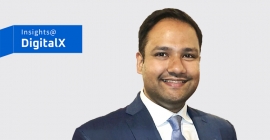‘Align with trends that promise to shape the dynamic marketing landscape’
Abhishek Gupta, Chief Marketing Officer, Edelweiss Tokio Life Insurance casts a glance back at the pivotal events that shaped India's marketing landscape in 2023.

As we embark on the journey into 2024, let’s cast a glance back at the pivotal events that shaped India's marketing landscape in 2023. We have witnessed the successful tenure of the G20 summit in India, the launch of the Chandrayaan-3 missions and have enjoyed the contagious sports fever that brought India to a radiant global stature. Meanwhile, the infusion of the 'Bharat' notion into marketing strategies also reflected a deliberate effort to connect authentically with the cultural fabric of the nation. As brands embraced AI-driven personalised communications, 2023 also marked a transformative era through purpose-driven communication and a new mandate for data-driven marketing. However, that’s not all!
In the insurance sector, the impact of key policy changes brought about an evolution in the marketing strategies. The Budget 2023 introduced a tax on proceeds of non-ULIP policies with annual premiums exceeding Rs 5 lakh, providing an incentive for increased sales while also propelling the industry towards retailisation. Alongside, the IRDAI State Insurance plan played a pivotal role in strategically targeting new and niche markets. It fostered hyper-personalisation and catalysed the development of a robust digital ecosystem within the insurance sector. Distributors took centre stage with a tailored strategy that enhanced opportunities and visibility, particularly within their specialised operating zones. This localised approach proved effective in reaching diverse markets and meeting the specific needs of consumers.
As we step into 2024, we must align ourselves with trends that promise to shape the dynamic marketing landscape, attuned to the evolving needs and expectations of the ever-discerning consumer.
I. Shift to Brand Building: Marketers are strategically pivoting from the focus on performance marketing to a more nuanced approach centred around brand building. Recognising the importance of fostering a strong brand identity, particularly among the Gen Z demographic, brands are investing time into creating a compelling narrative that goes beyond immediate sales. This shift does not negate the need for measurable ROI but places it within the broader context of cultivating a brand that resonates with consumers on a deeper level.
Sustainability and Ethical Marketing: Brands will continue to embrace a meticulous approach, integrating sustainability and ethical considerations into their marketing strategies. This reflects a commitment to environmental causes and social responsibilities, aligning with the values of an increasingly aware consumer base.
II. AI Will Find a Way: The integration of AI allows for more strategic and efficient creative work, leading to increased investment in this technology.
AI led Conversational Marketing: Conversational Marketing is poised to transcend its traditional boundaries through predictive analytics that will play a crucial role in anticipating customer preferences and behaviours in real time. It will analyse vast amounts of data, including past interactions, purchasing history, and online behaviours, to deliver hyper-personalised content that resonates with individual customers. Voice-activated interfaces (local language) and natural language processing will become standard features.
AL, Big Data & Real-Time Analytics: We will witness a transformative shift as hyper-personalisation takes centre stage with seamless integration of Big Data and real-time analytics, empowering brands to gain unprecedented insights into consumer behaviours, preferences, and trends. Sophisticated algorithms will sift through massive datasets, allowing for the creation of highly tailored and personalised marketing campaigns. This granular understanding will extend to every interaction, from emails to social media advertisements, enhancing customer satisfaction and fostering brand loyalty.
III. Content & Platform Landscape:
- Vocal for local: Brands will prioritise language-specific content to reach a broader audience addressing not only the need for diversity but also fostering trust, inclusivity, and relatability among customers. This also aligns with the regulators goal of ‘Insurance for All by 2047' as it places emphasis on rural marketing initiatives in tier 2 & 3 cities, promoting insurance accessibility across diverse demographics.
- Media Fragmentation: The media landscape will experience further fragmentation driven by the introduction of advertisements on OTT premium platforms. Marketers will navigate this dynamic landscape by exploring innovative avenues to connect and engage with their audiences. This shift will encourage a re-evaluation of marketing mixes to adapt to evolving digital consumption patterns and preferences. Digital has now emerged as the medium of choice with accelerated OTT adoption, gaming, e-commerce, etc., and investment in digital ad spends has also raised. So, while TV will continue to dominate spends, we will see continued growth in digital spends too.
- The Content Influencer Generation: The current trend of so called influencers will fade out and only those who are authentic would survive. Brands are recognising the value of collaborating with influencers deeply invested to their audience, fostering genuine connections and have created their niche market. This strategic shift aligns with brands' efforts to engage specific demographics in a more personalized and authentic way.
- Audio & Video Marketing and Short-Form Content Dominance: Video marketing, particularly through short-form platforms like Instagram Reels and YouTube Shorts, will continue dominate. The transient nature of short-form content, combined with its engaging visual appeal aligns perfectly with the shorter attention spans of modern audiences. Brands will continue leveraging short-form videos not only for advertisements but also for storytelling, product launches, and customer testimonials. However, long-form videos will prove to be ever green as they are most apt to drive certain complex and in-dept ideas.
Anticipate a surge in momentum for audio platforms, such as podcasts, with evolving features akin to OTT platforms. These changes may include user-generated recommendations and enhanced discoverability. While some argue about the current challenges in podcast discoverability due to limited technological developments for audio search engine optimisation, this landscape is evolving. Over time, expect newsworthy podcast content to surface more regularly on widely used platforms. The convergence of video and audio marketing is reshaping how brands connect with audiences, offering a dynamic and multifaceted approach to storytelling and promotion.

Stay on top of OOH media trends










